

Hip pain coming from the hip is a fairly common condition that is seen in the Orthopaedic clinics. Many a times people confuse low back ache with radiation into the buttocks as being hip problem. Hip pain however is a different entity and there are separate clinical signs and symptoms which can be used to distinguish it from the back problem.
It is a very disabling condition for the patients. Simple activities like getting up from a sitting position or swinging the legs to get into the car or even standing in line can be a severely painful procedure. In the Indian sub continent majority of the people who suffer from this are on the younger side hence even keeping up with their occupation can be very difficult to manage. We have seen people as young as 35 yrs also coming to the clinic on a wheel chair because of the severity of the pain.
Patients normally present with limping on walking a certain distance and on standing for certain intervals of time. Sleep is often disturbed specially while turning over in the bed and inability to lie on the affected side. Bending down to tie shoelaces and cutting of toe nails can become a big problem. There is marked stiffness in the hip joint so sitting on a low surface and getting in and out of a car often takes a long time.
The causes of hip arthritis are very many.
Primary arthritis of the hip just like arthritis of the knee is relatively rare in our country as compared to the western part of the world. No obvious cause for this has been described but still it is frequent enough to be picked up from time to time in the clinic. In this pattern essentially there is no disease or condition which has caused the arthritis to develop. The primary arthritic hips normally present after the age of 60 years.
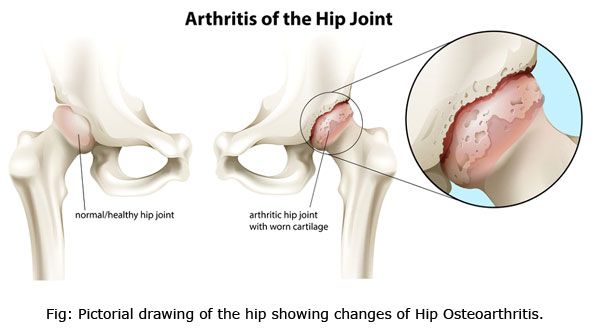
Secondary arthritis is secondary to either avascular necrosis of the hip joint , infection of the bone or Congenital or developmental mal development of the hip, Secondary to a developmental childhood condition such as Perthes hip or a Slipped femoral epiphysis , Secondary to a new or an Old injury including Mal United or non-union of fractures around the hip or of the pelvis . In our practice we see a huge number of patients who have developed Avascular necrosis, which is loss of blood supply of the hip which has led to collapse of the shape of the hip leading to arthritis because of rubbing of uneven surfaces . We have previously done hip replacement in even 18 yr old children for avascular necrosis or even Juvenile arthritis.
Clinical evaluation: Shows people working with a limp or a lurch often referred to as an antalgic gait. People will tend to lurch onto the affected side while walking. They often stand in a slightly skewed position trying to relieve the pressure on the affected side so that the weight does not fall on the affected hip joint. The range of movement is reduced especially rotation of the hip. There, are often certain deformities with the patient tending to lie down with the hip external rotated and bent upwards. At times the leg might be slightly shortened both because of the loss of cartilage height, position of the hip and also because of collapse of the femoral head.
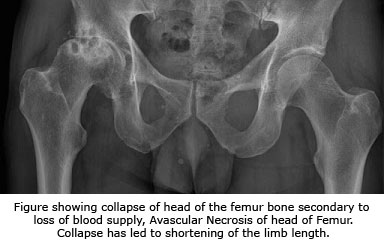
Investigations, normally an x ray is enough to diagnose hip arthritis. Some surgeons insist on having standing X rays because that will pick up even a slight reduction of hip space or the loss of thickness of the cartilage. X ray will show reduction of the space between the Femoral head and the Acetabulum Cup. It will also show some extra bone forming around the joint along with presence of cystic areas within the joint surfaces.
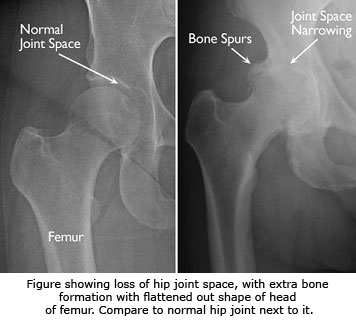
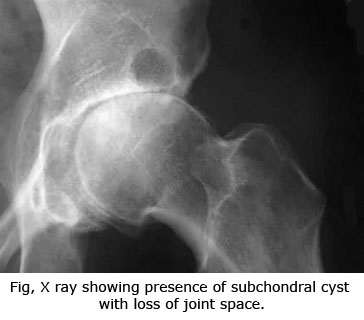
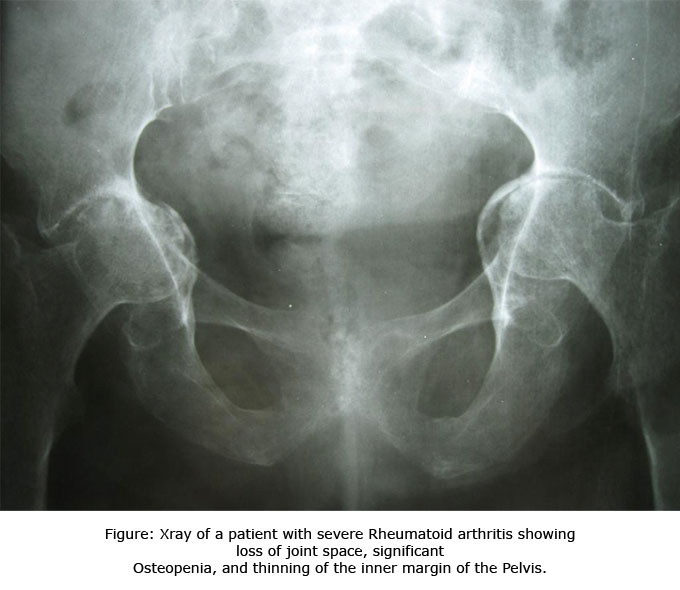
MRI / CT scan can be used if diagnosis is in doubt. Occasionally altered bone consistency either because of some fluid collection in or around the hip or very subtle fractures or bone depression me actually point towards a diagnosis if in doubt. it is of a definite add vantage to rule out infection maybe 2 burglars or bacterial very subtle injury which is not evident on clinical examination or on x rays.
Treatment really depends on the amount of disability and discomfort that the patient has. It's rare to have people come very early for hip arthritis unless a job involves sitting on the ground or sitting cross legged for long durations. However often people sitting on the Indian toilet feel the disability very early as they cannot undertake their daily morning routine. As a lot of us have now shifting to more western way of living which is sitting on chairs and walking rather than having any ground-based activities, we can normally manage the pain for long duration.
In the early phases we can try
Injections into the hip which could be either steroids or Hyaluronic Acid also called aisle euro Nick acid. hey, did you have a role in early arthritis for pain relief. they must be combined with some element of physiotherapy which would involve stretching out the contracted muscles and ligaments and also strange ring the major muscles which move the head.
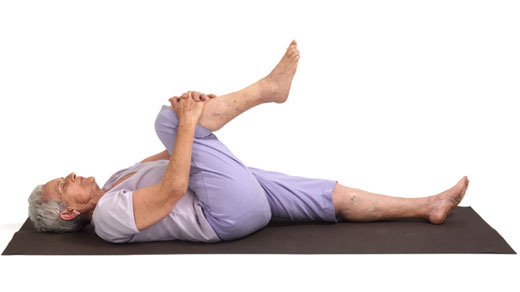
Advanced arthritis in which the hip is significantly worn out, the only option that works is a Hip replacement. This involves removing the head and putting in an artificial hip and also reaming out the normal socket (acetabulum) and inserting an artificial Hip.
The artificial implant then sits in contact with the artificial socket and the patient can bear weight on this. The artificial hips come in various designs and options. There are many options for this which essentially involve different surfaces for articulation involving the ball and the socket surfaces.
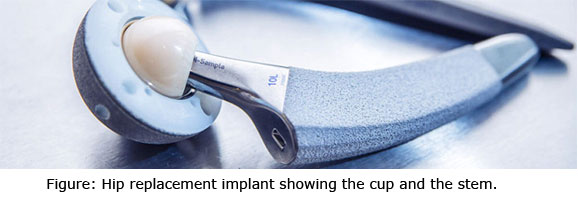
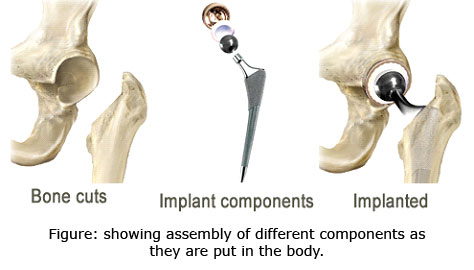
The artificial hip can be Cemented or Uncemented. The surfaces in touch with each other can be made of metal or ceramic on the Ball or the Thigh bone side and polyethylene or ceramic on the Cup side also known as the Acetabular side. The decision on which is more appropriate can be made by discussion between the patient and the treating surgeon. It would be fair to say that the uncemented hip hip implants are getting more popular as the long term results seem to be better in these implants.
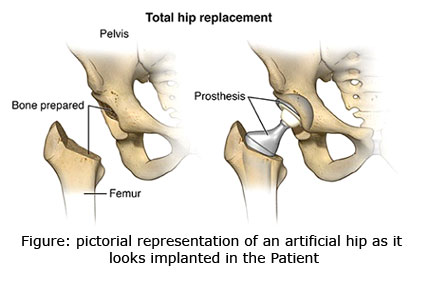
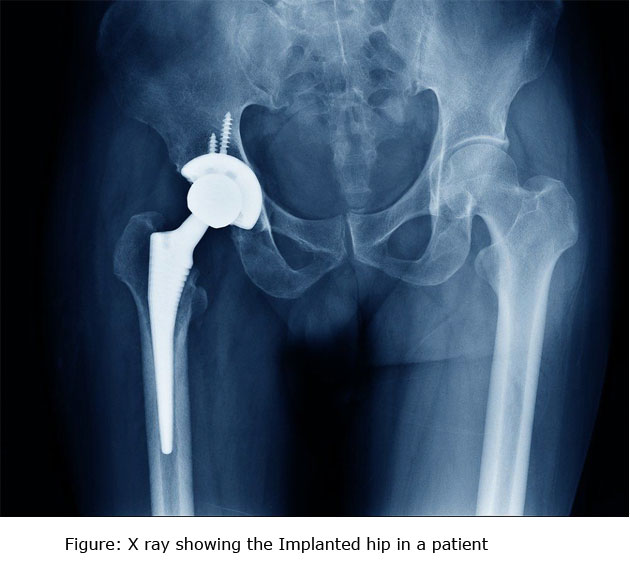
In our country because of the young age of a lot of people with Hip arthritis we use uncemented hip replacements much more often. We've been doing this surgery for a very long time and have follow-ups exceeding 20 years for some of our patients. We have also revised hips previously replaced with new hip replacements if that was required for that patient.
There is no appropriate age for this surgery but is a decision made based on the X ray, clinical findings and patients disability.